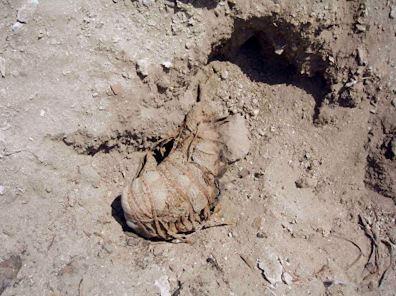Massive looting reported at El Hibeh, Egypt
Source - Save El Hibeh Egypt Facebook Group
|

|
Tomb with a beautiful uraeus frieze opened by looters and all contents destroyed [Credit: UC Berkeley]
|
After Egypt’s revolution, priceless artifacts were stolen from the nation’s world-famous Egyptian Museum in Cairo as well as from innumerable storehouses scattered throughout the country.
Today the continued plundering of archaeological sites, which comprise Egypt’s cultural heritage in its most pristine state, presents an even more critical challenge as sites are often remote and protected by low-paid guards and state security seems unable or unwilling to halt the mayhem.
El Hibeh is one such site. On the east bank of the Nile in a particularly impoverished area of Egypt three hour’s drive south of Cairo, the archaeological site occupies about two square kilometers and includes cemeteries and the ruins of a walled ancient provincial town with a limestone temple, industrial facilities, houses and possible fort and governing residence. The remains date from the late Pharaonic, Graeco-Roman, Coptic and early Islamic periods (approximately 11th century BCE to eighth century CE). Hibeh is of special importance because it is one of very few relatively intact town sites remaining in Egypt and because of its extensive archaeological deposits dating to the Third Intermediate Period, Egypt’s last “Dark Age” and an era particularly poorly known archaeologically.
|

|
Double image showing the same part of the site as it was in 2009 (top) and today (2012) [Credit: UC Berkeley]
|
Eminent University of California, Berkeley archaeologist Dr. Carol Redmount arrived in Egypt in February to continue her archaeological work at the site after obtaining the proper permits from Egypt’s Supreme Council of Antiquities which controls all excavations in the country.
Twenty-four hours before departing for the site her permits were revoked by the provincial police service with no explanation. Inquiries revealed that a mafia-like gang led by an escaped convicted criminal have been ruthlessly looting the site since at least June 2011. The Supreme Council of Antiquities has been unable to stop the pillaging despite repeated appeals to local police services. Open, systematic looting continues on a daily basis as of the writing of this press release. Dr. Redmount has not been allowed to visit the site nor do any work.
“Hibeh is vitally important to understanding the character of ancient Egypt in the Third Intermediate Period, a very confusing and confused historical era for which only limited archaeological resources exist. Archaeology is controlled destruction, but looting is obliteration. It destroys an irreplaceable, nonrenewable cultural resource that belongs to humanity,” says Dr. Redmount.
|

|
Exposed mummified child from the Coptic period [Credit: UC Berkeley]
|
Redmount’s team of six researchers from UC Berkeley is currently unable to do any of its proposed academic program at Hibeh for which they had received permission from the Egyptian authorities. This is costing the team tens of thousands of dollars in lost grants.
“Our primary concern of course is the incalculable loss of precious archaeological evidence. Archaeologists dream of excavating undistrubed or even relatively undisturbed historic sites. We are losing Hibeh for posterity as we speak,” adds Dr. Redmount.
Independent verification of the scale of the looting has been provided by visitors to the site who sent photos to Dr. Redmount, including pictures of looting in progress.